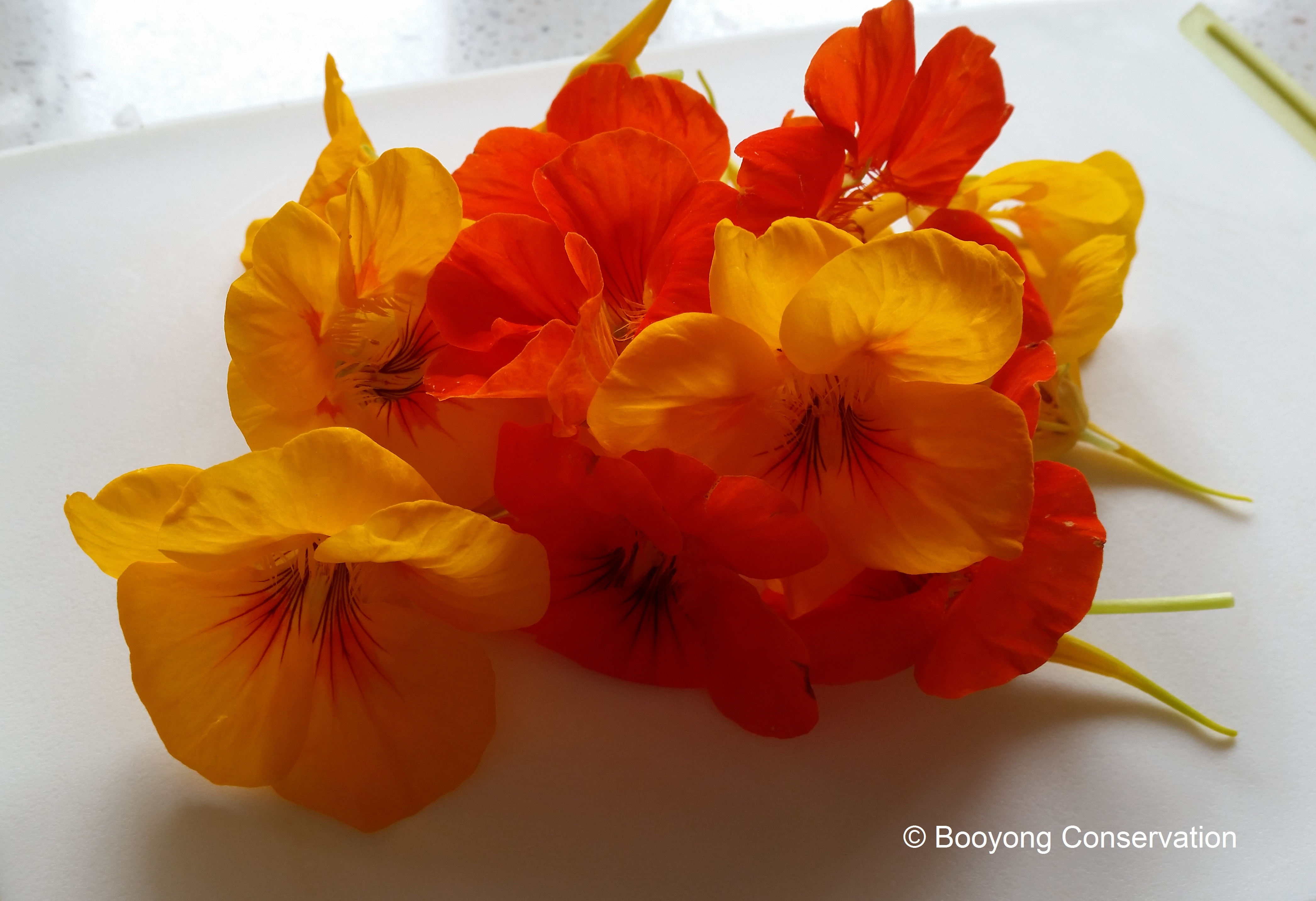Nasturtiums are annual edible flowers that are a wonderful addition to any garden and we have so many uses for them at Booyong. They are currently growing in a pot in the bunny enclosure (the bunnies love them), and they are planned to be a permanent feature on the floor of our food forest.
Nasturtiums have bright yellow and orange flowers and add colour to both the garden and dishes. They taste peppery  and have a flavour similar to watercress or mustard. Seeds can be pickled to make “Poor Man’s Capers”, flowers used to make flavoured butters, and young leaves are a great foundation for pesto and in fresh summer salads. However, nasturtium leaves cannot be dried so there is no need to wait after picking them. We also use them to decorate cakes and desserts as you can see!
and have a flavour similar to watercress or mustard. Seeds can be pickled to make “Poor Man’s Capers”, flowers used to make flavoured butters, and young leaves are a great foundation for pesto and in fresh summer salads. However, nasturtium leaves cannot be dried so there is no need to wait after picking them. We also use them to decorate cakes and desserts as you can see!
Not only are they beautiful but also nutritious, with the leaves and flowers having high levels of vitamin C which can assist with boosting our immunity, keep colds at bay and helps with bacterial and fungal infections.
Interestingly, “Nasturtium” comes from the Latin words meaning “twisted nose” and was named for the reaction on a person’s face after biting into the peppery leaves.
In the hot dry season, like long grasses Nasturtiums are a great hiding spot for snakes!
Nasturtium Pesto
 Pesto has been a long favoured addition to our fridge during the summer months and over time we’ve tried a variety of versions. These have been based on an original recipe which includes a bunch of basil, packet of pine nuts, salt and pepper, four garlic cloves, 1/3 cup grated parmesan cheese and olive oil all blended in the food processor.
Pesto has been a long favoured addition to our fridge during the summer months and over time we’ve tried a variety of versions. These have been based on an original recipe which includes a bunch of basil, packet of pine nuts, salt and pepper, four garlic cloves, 1/3 cup grated parmesan cheese and olive oil all blended in the food processor.
We have just included nasturtium leaves to make pesto and ginger could also be added. We have at times also used walnuts instead of pine nuts and added sundried tomatoes or chilli’s. It’s really up to you and your personal taste.
We place the pesto in a sterlisized jar in the fridge and cover the top with oil. Pesto can be eaten with pasta, on toast with bruschetta, as a pizza base or in a salad. Nasturtium pesto would also be lovely in a rice paper roll!
Soak young green Nasturtium seed pods covered in water and a table spoon of salt for two days. Rinse and add to one cup of boiled white vinegar with a teaspoon of sugar dissolved. Garlic or a Bay leaf can be added to the jar glass of covered seeds.
Another family favourite is to make flavoured butters and Nasturtiums are another wonderful option. Cut 12 Nasturtium flowers into small pieces and add to 125 grams of softened butter. Garlic, chill or ginger can be added along with parsley or coriander. Roll in glad wrap and place in freezer for use. Great on steaks, fish, chicken or placed over roasted vegetables.
Growing and Propagation
 Nasturtiums are fast growing both as ground covers and from hanging baskets and are available from spring and early summer. Once established they require little water which is great for our NSW summers, however they will be affected by extreme temperatures or high winds and frost. They grow well in poor soils and like sun or semi shade conditions.
Nasturtiums are fast growing both as ground covers and from hanging baskets and are available from spring and early summer. Once established they require little water which is great for our NSW summers, however they will be affected by extreme temperatures or high winds and frost. They grow well in poor soils and like sun or semi shade conditions.
They are easily propagated when seeds brown and fall off the plant and self-seed profusely. Seeds should be planted directly one inch deep and 10 inches apart and you can expect plants to appear in 7 to 10 days. They can also be cleaned, dried and stored for next year.
Nasturtiums are often used as a companion plant. Flowers attract pollinating insects and are often used as a sacrificial plant for brassicas by attracting caterpillars to its large leaves. Nasturtiums are also useful grown at the base of apple trees and amongst strawberries and tomatoes.



You must be logged in to post a comment.